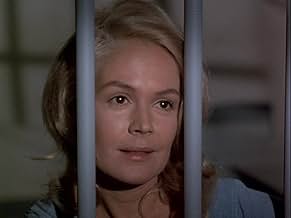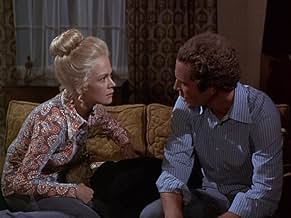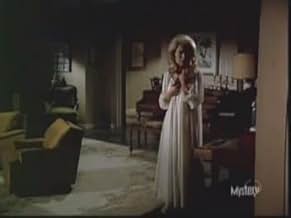The Different Ones/Tell David.../Logoda's Heads
- एपिसोड aired 29 दिस॰ 1971
- TV-PG
IMDb रेटिंग
6.6/10
367
आपकी रेटिंग
अपनी भाषा में प्लॉट जोड़ेंPaul Koch agrees to a unique solution that might help his hideously ugly son find acceptance. / A woman asks a couple for directions only to realize they represent her future. / A witch doct... सभी पढ़ेंPaul Koch agrees to a unique solution that might help his hideously ugly son find acceptance. / A woman asks a couple for directions only to realize they represent her future. / A witch doctor is suspected of murdering an explorer.Paul Koch agrees to a unique solution that might help his hideously ugly son find acceptance. / A woman asks a couple for directions only to realize they represent her future. / A witch doctor is suspected of murdering an explorer.
Françoise Bush
- Yvonne (segment "Tell David...")
- (as Francoise Ruggieri)
फ़ीचर्ड समीक्षाएं
This episode of "Night Gallery" is quite honestly just Rod Serling blatantly ripping himself off. "The Different Ones" is just "Eye Of The Beholder" from the original "The Twilight Zone" series with a boy instead of a girl and a planet of disfigured inhabitants...or is it two? The problem is that "Eye Of The Beholder" was directed with style and made the viewer care about the central characters of the story. The only thing "The Different Ones" has going for it is...well...that it's in color and incorporates some N.A.S.A. footage which I'm sure was riveting at the time. Oh, there was also some stock footage of what I believe was the monorail from Disney World to help make the planet Earth look futuristic...that was absolutely hilarious...along with some random announcements over a P.A. system concerning "flying policemen" (on very visible wires and some very bad green screen) and something about aliens landing and then later being found to be "friendly"...not sure what that was except possibly a way of stretching out the story to fit the formatted running time. This is definitely not one of the better "Night Gallery" episodes.
'The Different Ones'. Written by Mr. Serling, and directed by John Meredyth Lucas. Dana Andrews is solid as a father with a deformed teenage son (Jon Korkes). He doesn't have very many options in terms of dealing with the kid, then learns of an interplanetary "exchange program". The catch here is a warm and upbeat ending, something not that common for this series, where the kid is able to find acceptance, and will NOT have to put up with evil and taunting children any more. The twist is definitely reminiscent of Serlings' previous, legendary 'Twilight Zone' series, but it's nice to see a happy resolution to the character problems here. The episode also has something pertinent to say about the way that humans treat anybody who is "different".
'Tell David..." Scripted by Gerald Sanford, based on a story by Penelope Wallace, and directed by actor Jeff Corey. An interesting, "futuristic" tale with a theme about the damage that chronic jealousy can cause. Sandra Dee is fine as a motorist who stops at a strangers' house for directions, and meets some charming people (Jared Martin and Jenny Sullivan) who have some major relevance in her life. The writing here is fairly predictable, but at least the cast is endearing and the story engrossing. Ultimately, the lead character will be very conscious of her fate and will accept it, knowing that she will be forgiven.
'Logoda's Heads'. Scripted by "Psycho" author Robert Bloch, based on a story by August Derleth. A pretty standard yarn about voodoo and revenge in Africa, as the character Logoda (Brock Peters), a witch doctor, is suspected of having been involved with the death of a white explorer. While there is nothing really scary about this segment, the shrunken heads *are* creepy, and the actors (Patrick Macnee, Denise Nicholas, Tim Matheson, Albert Popwell, etc.) do a decent job.
Overall, this is NOT a great episode, but it is a good one.
Seven out of 10.
'Tell David..." Scripted by Gerald Sanford, based on a story by Penelope Wallace, and directed by actor Jeff Corey. An interesting, "futuristic" tale with a theme about the damage that chronic jealousy can cause. Sandra Dee is fine as a motorist who stops at a strangers' house for directions, and meets some charming people (Jared Martin and Jenny Sullivan) who have some major relevance in her life. The writing here is fairly predictable, but at least the cast is endearing and the story engrossing. Ultimately, the lead character will be very conscious of her fate and will accept it, knowing that she will be forgiven.
'Logoda's Heads'. Scripted by "Psycho" author Robert Bloch, based on a story by August Derleth. A pretty standard yarn about voodoo and revenge in Africa, as the character Logoda (Brock Peters), a witch doctor, is suspected of having been involved with the death of a white explorer. While there is nothing really scary about this segment, the shrunken heads *are* creepy, and the actors (Patrick Macnee, Denise Nicholas, Tim Matheson, Albert Popwell, etc.) do a decent job.
Overall, this is NOT a great episode, but it is a good one.
Seven out of 10.
'The Different Ones' - Dana Andrews plays a troubled father whose unhappy son is deemed too ugly to live in society, and so is sent on an interplanetary exchange mission which has unexpected results... Though derivative of "The Twilight Zone", episode 'Eye Of The Beholder', likable tale has a most heart-warming finale, a rarity for this series(that is part of the twist I think...)
'Tell David' - A woman(played by Sandra Dee) gets an unexpected trip to the future where an important warning goes unheeded... Good tale by story editor Gerald Sanford explores the nature of fate and responsibility.
'Lagoda's Heads' - Unremarkable tale of African voodoo revenge.
'Tell David' - A woman(played by Sandra Dee) gets an unexpected trip to the future where an important warning goes unheeded... Good tale by story editor Gerald Sanford explores the nature of fate and responsibility.
'Lagoda's Heads' - Unremarkable tale of African voodoo revenge.
I agree with an earlier reviewer that "The Different Ones" bears marked resemblances to Twilight Zone's "Eye of the Beholder," which Serling also wrote. The crucial difference is that "Eye" reeked of quality, whereas "Ones" reeks of ineptitude. The light and shadow play that characterized much of "Eye" kept us largely in the dark until it was revealed--at the bitter end--that the protagonist was the lone (or nearly lone) beauty adrift amid a hideously ugly populace. The episode made a sort of intrinsic sense: you could almost genetically divide it into the pig-people and the people-people. "The Different Ones," however, postulates utter lunacy: a profoundly deformed man on Earth is sent to a planet where the normal population just happen to match his every feature. As if that were not bad enough, his "profoundly deformed" counterpart from the planet Vorion is--guess what--a fellow who would pass for drop-dead gorgeous on Earth. Are the odds even calculable that, among two disparate planets, the outsiders of planet A would physically match the insiders of planet B, and vice-versa? PUH-LEEZ! (It's also profoundly ridiculous that--in the 1970s--we could be entirely ignorant of Vorion, a planet that, it is claimed, lies just beyond the orbit of Mars . . . but I digress.)
I take serious umbrage with "Logoda's Heads," as well, almost from top to bottom. First, the episode was profoundly cheaply filmed: assuming that my aging TV is not to blame--which it assuredly is not--the level of background lighting and tinting ranges from a light purple sky one moment to a deep green sky the next moment; and, while we trek from one valley, over a short hillock, to the next valley, the background lighting changes from day, to night, back to day. O.K. That's bad enough. Here's where the anthropology gets so backward that my beloved Prof. Stephanie Fins would be forced to commit seppuku. We have a black (= African) sorcerer, and a black "anti-sorcerer" (the young girl), and--I think--a black old woman situated among an Amazonian people. In addition to the Amazonian shrunken head fetishes ("tsantsas"), the Logoda is fond of shaking ironwood statuettes that are--unless my memory escapes me--quite West African, whether Dahomeyan or, in fact, Malian not being terribly important. Then, the young girl refers to the "native" animals, to wit, leopards and hyenas--none of which are to be found in South America (though, I'm sure, some rake will point out, "Aha! You can find leopards and hyenas at the Sao Paulo zoo!" {There's one in every crowd.}). I mean, how ridiculous does ridiculous get? There is definitely some good material to be found on Night Gallery, but you won't find it amid this pair of corkers!
I can't comment on the third segment about "David" insofar as my chopped, sliced, diced, and regurgitated version of "Night Gallery" as shown on the MeTV cable network at 1:30AM did not condescend to sport that third piece. Pity.
I take serious umbrage with "Logoda's Heads," as well, almost from top to bottom. First, the episode was profoundly cheaply filmed: assuming that my aging TV is not to blame--which it assuredly is not--the level of background lighting and tinting ranges from a light purple sky one moment to a deep green sky the next moment; and, while we trek from one valley, over a short hillock, to the next valley, the background lighting changes from day, to night, back to day. O.K. That's bad enough. Here's where the anthropology gets so backward that my beloved Prof. Stephanie Fins would be forced to commit seppuku. We have a black (= African) sorcerer, and a black "anti-sorcerer" (the young girl), and--I think--a black old woman situated among an Amazonian people. In addition to the Amazonian shrunken head fetishes ("tsantsas"), the Logoda is fond of shaking ironwood statuettes that are--unless my memory escapes me--quite West African, whether Dahomeyan or, in fact, Malian not being terribly important. Then, the young girl refers to the "native" animals, to wit, leopards and hyenas--none of which are to be found in South America (though, I'm sure, some rake will point out, "Aha! You can find leopards and hyenas at the Sao Paulo zoo!" {There's one in every crowd.}). I mean, how ridiculous does ridiculous get? There is definitely some good material to be found on Night Gallery, but you won't find it amid this pair of corkers!
I can't comment on the third segment about "David" insofar as my chopped, sliced, diced, and regurgitated version of "Night Gallery" as shown on the MeTV cable network at 1:30AM did not condescend to sport that third piece. Pity.
These three episodes are a little on the weak side, in my opinion. The first "The Different Ones," for me, was just warmed-over Twilight Zone. A young man who lives in an "advanced" culture has the great misfortune to be born deformed. He is hideous to the eyes of everyone and his father, who feels greatly for his misfortune, doesn't know what to do. One of the options for people born this way is termination. They have, for whatever, reason, developed an exchange program with another planet. The wind up...and the pitch.
"Tell David..." is an odd episode. A woman loses her way, trying to find her house, and ends up getting help from some odd people. They have technology beyond that which she is used to. David, the young man (who has the same name as her little boy) is a master at repairing devices she's never seen. When she returns to her husband, he is dressed as a monster and nags at her and chases her. It is obvious that this is the way he sees her. She is monumentally jealous. She comes to realize that she has an opportunity to change her history, to prevent herself from doing a deadly thing. As it goes along, it becomes nonsensical. It also gets caught in the problems with the mutation of time.
"Lagoda's Heads" concerns a couple of men who visit a medicine man in an African jungle. The brother of one of them has disappeared and it is suspected that Lagoda, the medicine man, is responsible. Lagoda does things with shrunken heads that he talks to. He also can put curses on people. A young woman who is cursed, tells the man his brother has been there. Through a series of spells and counter-spells involving the young woman, everything comes to a "head." Or I guess it's heads. Terrible acting and another convoluted plot.
"Tell David..." is an odd episode. A woman loses her way, trying to find her house, and ends up getting help from some odd people. They have technology beyond that which she is used to. David, the young man (who has the same name as her little boy) is a master at repairing devices she's never seen. When she returns to her husband, he is dressed as a monster and nags at her and chases her. It is obvious that this is the way he sees her. She is monumentally jealous. She comes to realize that she has an opportunity to change her history, to prevent herself from doing a deadly thing. As it goes along, it becomes nonsensical. It also gets caught in the problems with the mutation of time.
"Lagoda's Heads" concerns a couple of men who visit a medicine man in an African jungle. The brother of one of them has disappeared and it is suspected that Lagoda, the medicine man, is responsible. Lagoda does things with shrunken heads that he talks to. He also can put curses on people. A young woman who is cursed, tells the man his brother has been there. Through a series of spells and counter-spells involving the young woman, everything comes to a "head." Or I guess it's heads. Terrible acting and another convoluted plot.
क्या आपको पता है
- ट्रिवियाThe segment "The Different Ones" uses several sound effects that would later be used in The Six Million Dollar Man (1974), including the effect used when Steve Austin activates his bionic eye.
- गूफ़The title character in "Logoda's Heads" is an African witch doctor who collects shrunken heads. While some South American Indian tribes are known to have practiced head shrinking, no African tribe has ever done so.
- इसके अलावा अन्य वर्जनThe syndication version took this The Different Ones segment and worked it into a whole half hour segment. This was done by using stock footage from Fahrenheit 411 and Silent Running. Silent Running was released after the network airing of the segment.
- कनेक्शनEdited from This Island Earth (1955)
टॉप पसंद
रेटिंग देने के लिए साइन-इन करें और वैयक्तिकृत सुझावों के लिए वॉचलिस्ट करें
विवरण
- ध्वनि मिश्रण
- पक्ष अनुपात
- 1.33 : 1
इस पेज में योगदान दें
किसी बदलाव का सुझाव दें या अनुपलब्ध कॉन्टेंट जोड़ें

























